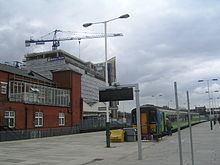- Bay platform
-
Bay platform is a railway-related term commonly used in the UK and Australia to describe a dead-end platform at a railway station that has through lines.[1] It is normal for bay platforms to be shorter than their associated through platforms.
Overview
Bay and island platforms are so named because they resemble the geographic features of the same name.
Examples of stations with bay platforms include Carlisle railway station; Nottingham railway station (pictured), which has a bay platform inset into one of its platform islands; and the San Francisco International Airport BART Station which has three bay platforms, two of which are in use. Chicago's CTA O'Hare Airport Station features a bay platform with one track on the bay and a track on each side of the platform. The Hoboken and 33 St Stations on the PATH train line have bay platforms. Ferry Avenue on the PATCO Speedline also has a bay platform.
Trains which use a bay platform have to reverse direction and depart in the direction from which they arrived.
Hakodate Station in Hokkaido, Japan was originally used as a connection from railway to a railway-ferry crossing the Tsugaru Strait. After the Seikan Tunnel was opened, Hakodate Station has now six tracks as a bay platform.
Dock platforms
Dock platforms are similar to bay platforms but are generally shorter and used to unload freight.
References
- ^ Mortimer, Simon (2007). Baywatch (4th edition). Kentrail Enthusiasts Group.
Railway track layouts Running lines Rail sidings Junctions Stations Side platform • Island platform • Bay platform • Split platform • Terminal station • Balloon loop • Spanish solution • Cross-platform interchange • Interchange stationHillclimbing 
This United Kingdom rail transport related article is a stub. You can help Wikipedia by expanding it.

